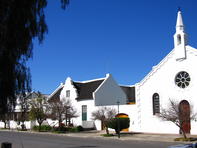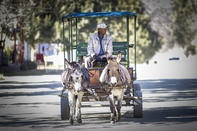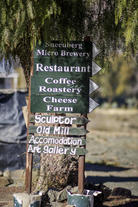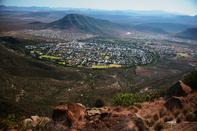Visit Graaff-Reinet
Karoo history spans thousands of years and includes the era of Bushman hunter-gatherers and Khoikhoi herders, Huguenot, German and Dutch pastoralists and English settlers.

Listen to anecdotes on the veranda of a local while sipping or choking on your coffee or tea as they regale you with amusing tales which may well be relayed in the local lingo of Graaffrikaans. Storytelling is deeply entrenched in the Graaff-Reinet experience.
The Artists’ Route is well worth exploring, especially considering that the Karoo is home to over 60 000 cave painting sites. The /Xam people painted their history, mythology and literature on caves and rock walls. Their descendants, the First People Artists, create art alongside potters, sculptors and painters.
Other Attractions

Other fascinating attractions include the Hester Rupert Art Museum and the collections of Cape Silver in the Dutch Reformed Church, which dominates the town with its central location and high steeple. More than 200 buildings in Graaff Reinet are national monuments. Experience the history of the town from a horse-drawn carriage, offering an insightful introduction to the well maintained Cape-Dutch architecture of this historic place.
Other recommended visits include the Reniet House in Murrey Street, the Old Residency in Parsonage Street, the Old Library and the Drostdy in Church Street. Graaff-Reinet is located on the N9, linking the Garden Route town of George with the N1 at Coleberg, and then to Johannesburg. Graaf Reniet is about 300 kilometres from George and 800 kilometres from Johannesburg.
The Graaff-Reinet Culinary Route

The Culinary Route serves up the best of Karoo hospitality. Take your pick from coffee shops, breweries, delicatessens and breweries. Melktert (milk tart), koeksusters (plaited doughnut dipped in syrup), boontjiesop (bean soup), rusks, ginger beer, free-range Karoo lamb and venison on the menu. Especially popular is the fillet-trio of springbok, beef and ostrich.
Other delights likely to make their way onto your plate may include kudu, kudu-salami, blesbok pie with roast potatoes and glazed sweet potatoes. Meals are often rounded off with traditional malva pudding (a sweet pudding with apricot jam and a caramelized texture and cream sauce).
For Adventure Seekers

Adventure seekers such as hikers and mountain bikers can head for the Sneeuberg mountain range or picnic, yacht, windsurf, powerboat, waterski, canoe or fish at Nqweba Dam. Camdeboo National Park offers various 4x4 routes. Birders, too, are in for a real treat here. You may be fortunate to spot a black eagle at close range.
Here you can also get up close and personal with black wildebeest, red wildebeest, eland, ostrich, springbok, buffalo, kudu, zebra and blesbok, to name a few. Marvel at an aerial view of the town from the Toposcope. The Valley of Desolation includes a dolerite column that was formed in excess of 200 million years ago.
A walking or horse carriage tour exposes you to a remarkable amount of period architecture typical of a 19th-century rural town. Here you will find the largest number of proclaimed national monuments of any South African town. Magnificent Cape Dutch mansions, Victorian cottages, Georgian houses and flat-roofed Karoo cottages rank among national monuments.